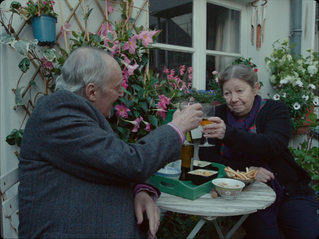The Master
- Jack Synnott
- Feb 19, 2022
- 3 min read
Paul Thomas Anderson, 2012

“Do you know what you look like?”
- The Fall, ‘Look, Know’
There are a number of climaxes at the climax of Paul Thomas Anderson’s The Master.
Freddie Quell, the drifter we have been following as he rises (or falls) through the labyrinthine ranks of the cultish Cause, will conclude the film in a moment of ecstasy, trying (or failing) to apply The Cause’s therapeutic methods during a one night stand. Perhaps, as the film’s closing flashback provocatively hints, the ecstasy came much earlier, during Freddie’s military station in Japan, when his only intimate companion was a woman-shaped sandcastle. Either way, the film ends in an orgasmic register, foregrounding Freddie’s pleasure - a pleasure shown clearly to us only after he has left The Cause behind.
What, then, are we to make of an earlier climax? Freddie announces his departure from The Cause (in this life at least) to Lancaster Dodd, the movement’s leader (and possibly, though not incontestably, The Master of the film’s title). They have shared an intense relationship, constituted (or constitutively unconstituted) by boundaries that constantly shift, as the waves iwe see from above during the film’s many instances of travel by sea: like Freddie’s wartime lover, they are made of sand. Lancaster’s response to Freddie is staggering - maintaining a blazing gaze, he sings an a capella rendition of “Slow Boat to China”.
We hold on Lancaster in close up, diagonally bisecting the screen, his head in a slight shake as he sings the song’s opening lines: “I’d love to get you\ On a slow boat to China.” All too soon, we cut back to Freddie for the response to this call: “All to myself\ Alone.” Lancaster sings both parts - he (thinks he) is in control of this sequence. Considering the shot of his face is illuminating.
What we are presented with as spectators is the chance to study Lancaster’s face. This is also the chance to study the face of Philip Seymour Hoffman, a frequent Anderson collaborator who collaborates here for the last time before his death. Both of these chances are also the chance to consider a face that looks out at us, and that is looked at by Freddie, by us. Does he know what he looks like?
In a short essay on Greta Garbo, Barthes writes that she “belongs to that moment in cinema when capturing the human face still plunged audiences into the deepest ecstasy”. Hoffman resurrects that tradition, his totalising performance giving us the sense that this singing/gazing (or gazing/singing) is as climactic as Freddie’s later sexual encounter(s). Like Garbo, he provides us with “an admirable face-object”.
The sense of rapture is enhanced by the rows of windows that make up the shot’s background, illuminating the frame (and Lancaster within it). His gaze is itself illuminating, casting its rays on Freddie and throwing into light his inner intensity. We are dealing with a case of super-illumination. In their rigid patterning, the windows recall the stained-glass of a church. Lancaster’s shirt too, just about visible (or illuminated) at the bottom of the frame, recalls the white dog collar of a priest. Lancaster becomes a religious figure at the same time he becomes a figure of desire. This illuminates a pertinent fact of The Master’s conclusion: a climax can be more than one kind of climax.
Just as there is more than one way of looking, there is more than one way of looking at. Depending on the angle, we can view Lancaster as a charlatan or a saviour, Freddie’s friend or enemy, The Master or the one mastered. Perhaps what makes this shot climactic is its insistence that we look at Lancaster from only one angle - the same one as Freddie. That he still presents these exciting and terrifying multiplicities may simply be a trick of the light.








Comments